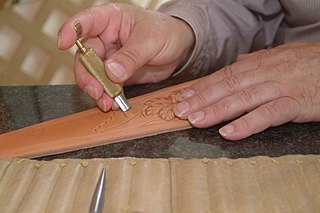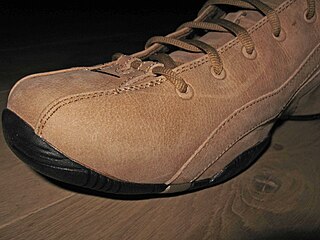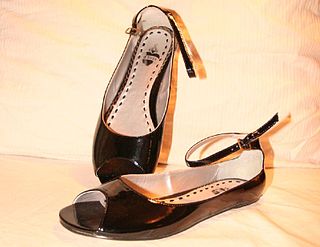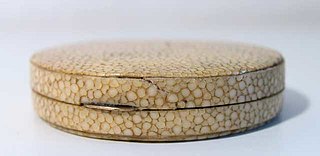 W
WLeather is a durable and flexible material created by tanning animal rawhide and skins. The most common raw material is cattle hide. It can be produced at manufacturing scales ranging from artisan to modern industrial scale.
 W
WAnthropodermic bibliopegy is the practice of binding books in human skin. As of May 2019, The Anthropodermic Book Project has examined 31 out of 50 books in public institutions supposed to have anthropodermic bindings, of which 18 have been confirmed as human and 13 have been demonstrated to be animal leather instead.
 W
WBoiled leather, often referred to by its French translation, cuir bouilli, was a historical material for various uses common in the Middle Ages and Early Modern Period. It was leather that had been treated so that it became tough and rigid, as well as able to hold moulded decoration. It was the usual material for the robust carrying-cases that were made for important pieces of metalwork, instruments such as astrolabes, personal sets of cutlery, books, pens and the like. It was used for some armour, being both much cheaper and much lighter than plate armour, but could not withstand a direct blow from a blade, nor a gunshot.
 W
WBonded leather, also called reconstituted leather or blended leather, is a term used for a manufactured upholstery material which contains animal hide. It is made as a layered structure of a fiber or paper backer covered with a layer of shredded leather fibers mixed with natural rubber or a polyurethane binder that is embossed with a leather-like texture.
 W
WBuckskin is the soft, pliable, porous preserved hide of an animal – usually deer – tanned in the same way as deerskin clothing worn by Native Americans. Some leather sold as "buckskin" may now be sheepskin tanned with modern chromate tanning chemicals and dyed to resemble real buckskin.
 W
WCalfskin or calf leather is a leather or membrane produced from the hide of a calf, or juvenile domestic cattle. Calfskin is particularly valuable because of its softness and fine grain, as well as durability. It is commonly used for high-quality clothing, shoes, wallets, and similar products, as well as traditional leather bookbindings. In these contexts, just "calf" is commonly used. Fine calfskin is one of the skins used for vellum and parchment manuscripts.
 W
WChamois leather is a type of porous leather, traditionally the skin of the chamois, a type of European mountain goat, but today made almost exclusively from the flesh split of a sheepskin.
 W
WThe conservation and restoration of parchment constitutes the care and treatment of parchment materials which have cultural and historical significance. Typically undertaken by professional book and document conservators, this process can include preventive measures which protect against future deterioration as well as specific treatments to alleviate changes already caused by agents of deterioration.
 W
WCorinthian leather is a term coined by the advertising agency Bozell to describe the upholstery used in certain Chrysler luxury vehicles. The term first appeared in advertising in 1974. Although this is merely a marketing concept, it suggests that the term—not the product—was inspired from the more elaborate and impressive ancient Greek column of the Corinthian order.
 W
WCowhide is the natural, unbleached skin and hair of a cow. It retains the original coloring of the animal. Cowhides are a product of the food industry from cattle. Cowhide is frequently processed into leather.
 W
WLeather wallpaper is a type of wallpaper used in various styles for wall covering. It is often referred to as wrought leather. It is often gilded, painted and decorated. With the advent of wallpaper use from about 1650-1750, leather was used to cover and decorate sections of walls in the habitations of wealthy persons. Leather is pliable and could be decorated in various ways.
 W
WLeather carving is the process of giving a three-dimensional appearance to leather craft objects or works of art by cutting and stamping the surface.
 W
WLeather crafting or simply leathercraft is the practice of making leather into craft objects or works of art, using shaping techniques, coloring techniques or both.
 W
WLeather wallpaper is a type of wallpaper used in various styles for wall covering. It is often referred to as wrought leather. It is often gilded, painted and decorated. With the advent of wallpaper use from about 1650-1750, leather was used to cover and decorate sections of walls in the habitations of wealthy persons. Leather is pliable and could be decorated in various ways.
 W
WMink oil is an oil used in medical and cosmetic products. It is obtained by the rendering of mink fat which has been removed from pelts destined for the fur industry.
 W
WMorocco leather is a soft, pliable form of leather widely used for gloves and the uppers of ladies' shoes and men's low cut shoes, but traditionally associated with bookbindings, wallets, linings for fine luggage, and the like.
 W
WNeatsfoot oil is a yellow oil rendered and purified from the shin bones and feet of cattle. "Neat" in the oil's name comes from an Old English word for cattle. Neatsfoot oil is used as a conditioning, softening and preservative agent for leather. In the 18th century, it was also used medicinally as a topical application for dry scaly skin conditions.
 W
WNubuck is top-grain cattle leather that has been sanded or buffed on the grain side, or outside, to give a slight nap of short protein fibers, producing a velvet-like surface. It is resistant to wear, and may be white or coloured.
 W
WOstrich leather is the result of tanning skins taken from African ostriches farmed for their feathers, skin and meat. The leather is distinctive for its pattern of bumps or vacant quill follicles, ranged across a smooth field in varying densities. It requires an intricate, specialised and expensive production process making its aesthetic value costly.
 W
WPatent leather is a type of coated leather that has a high-gloss finish. The coating process was introduced to the United States and improved by inventor Seth Boyden, of Newark, New Jersey, in 1818, with commercial manufacture beginning September 20, 1819. Boyden's process used a lacquer coating that was based on linseed oil. Modern patent leather usually has a plastic coating.
 W
WPiteado is an artisan technique where pita or ixtle is embroidered onto leather in decorative patterns. The technique is used to make belts, sandals, hair bands, saddles, and other leather accessories. The technique is popular in Mexico and Central America, and typical designs include flowers, animals, charreada, and Pre-Hispanic symbols.
 W
WRed rot is a degradation process found in vegetable-tanned leather.
 W
WRostaing is a company created in 1789 by Joseph Rostaing which was at first a tannery.
 W
WShagreen is a type of rawhide consisting of rough untanned skin, historically from a horse's or onager's back, or from shark or ray. In modern times, shagreen is produced from the skins of commercially farmed Asian stingrays.
 W
WShell cordovan is a type of leather commonly used in high-end shoemaking. Cordovan is an equine leather made from the fibrous flat connective tissue beneath the hide on the rump of the horse. The leather derives its name from the city of Cordoba, Spain, where it was first produced by the Visigoths in the seventh century, and later also by the Moors. It is a difficult and expensive leather to make, and in the late 19th and early 20th century was mostly used for razor strops to sharpen razors in barber shops. More recently it has been increasingly used for shoes, wallets, and watch straps due to its aesthetic qualities and exceptional durability. Shell cordovan has a unique non-creasing characteristic. Because it is made of connective tissue, it is smooth and lacks the pebbled effect of leather derived from animal skin.
 W
WSuede is a type of leather with a napped finish, commonly used for jackets, shoes, shirts, purses, furniture, and other items. The term comes from the French gants de Suède, which literally means "gloves from Sweden".
 W
WA swivel knife is a chisel-edged blade held upright and mounted on a pivot with a saddle for a finger. It is held somewhat like a pencil, but between the thumb and middle fingers, while the forefinger rides in the saddle above. It is used to outline and cut a design into the surface of leather as an initial stage to tooling the leather with decorations.
 W
WLeather is a durable and flexible material created by tanning animal rawhide and skins. The most common raw material is cattle hide. It can be produced at manufacturing scales ranging from artisan to modern industrial scale.